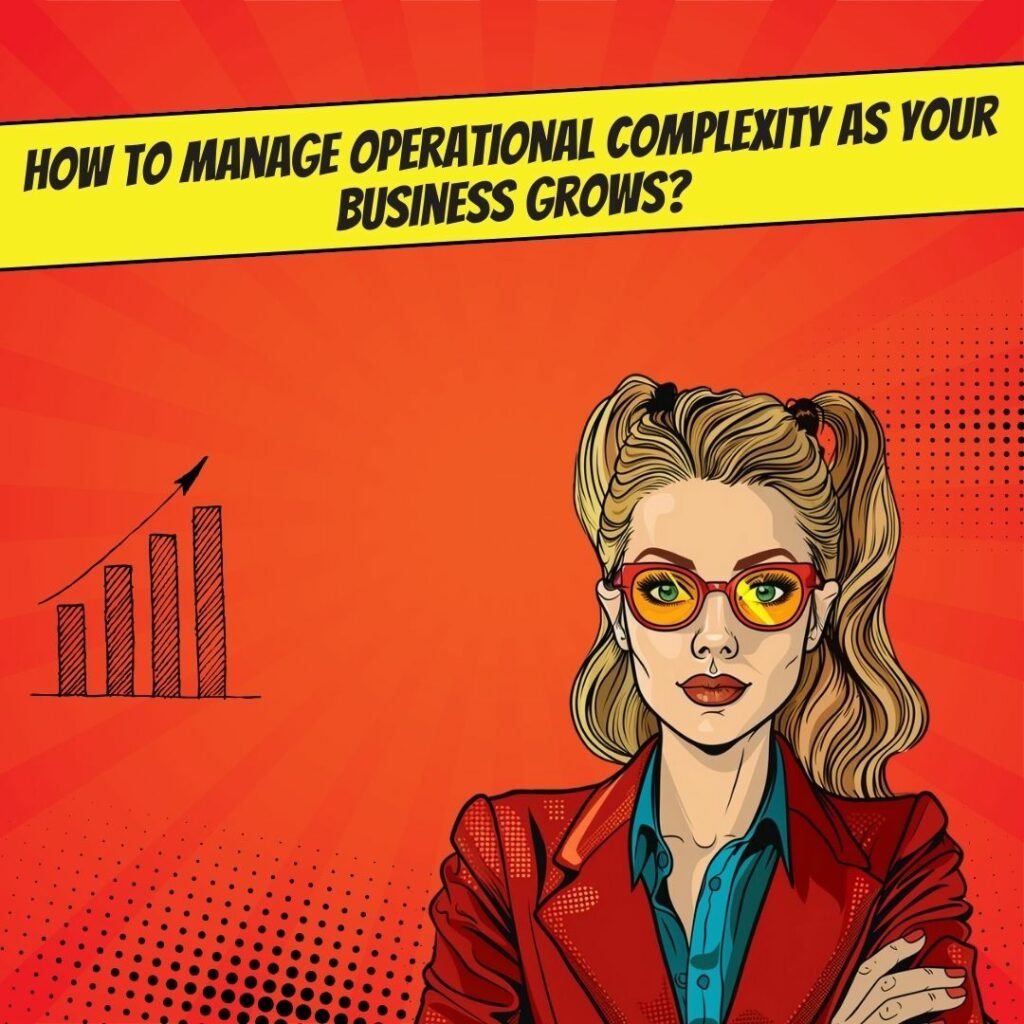Key Takeaways
✅ Embrace Complexity and Adapt: Understanding that complexity is part of today's business landscape is the first step. By incorporating continuous improvement practices and flexibility, businesses can stay agile. Statistics show that companies that regularly review and adapt their strategies can see up to a 33% increase in efficiency.
✅ Streamline Processes and Leverage Technology: Simplifying processes and making smart use of technology, such as automation and data analytics, can lead to significant operational improvements. Businesses that have embraced digital transformation report up to a 40% boost in productivity.
✅ Foster a Collaborative Culture: Promoting teamwork and open communication not only enhances problem-solving but also innovation. Companies with a strong collaborative culture are 5 times more likely to be high-performing.
 Introduction
Introduction
Have you ever stopped to wonder just how complex running a business has become? Whether it's the labyrinth of global supply chains, the breakneck pace of technological change, or the shifting sands of consumer demand, today's businesses face a maze of complexity. Operational complexity is not just a buzzword; it's a reality that can make or break your business.
In this digital age, ignoring the intricacies of your operations can lead to inefficiencies that stifle growth and innovation. On the flip side, mastering the art of managing operational complexity can set you up for unparalleled success. This article dives deep into the whirlwind of challenges and triumphs related to handling complex business operations. It offers a clear roadmap to streamline your processes, embrace technological advances, and foster a workplace culture that thrives on collaboration and adaptability.
Prepare to uncover a treasure trove of insights and strategies that will not only help you navigate the stormy waters of complexity but also sail ahead of your competition. With expert advice and cutting-edge trends at your fingertips, you'll learn how to maximize not just revenue but your return on every aspect of your business investments. Get ready to discover actionable tips that will transform your operations and fuel your next phase of growth.
Top Statistics
| Statistic | Insight |
|---|---|
| Digital Transformation and Complexity: The COVID-19 pandemic accelerated digital transformation, increasing business operations complexity. | This shift reflects the urgent need for businesses to adapt quickly to changing environments, showcasing how digital tools are at the forefront of managing operational challenges. |
| App Deployment and Data Silos: Organizations have seen a 24% increase in deployed apps since 2016, averaging 187 apps for large companies. | Indicates the growing reliance on digital apps but also highlights potential challenges in managing these resources efficiently without creating data silos. |
| IT Spending and Digitization: 51% of companies plan to increase their IT spending in 2023 to accelerate use cases and advanced analytics. | Despite economic concerns, organizations are investing significantly in IT to ease complexities through digitization and advanced analytics, pointing towards a trend in prioritizing operational efficiency. |
| Data Governance Challenges: The most significant challenge is disparate data sources and systems, impacting data availability, usability, cost-effectiveness, and security. | Emphasizes the necessity for integrated data governance models to handle the increased complexity and ensure seamless operations. |
Understanding Operational Complexity
When we talk about operational complexity, we're referring to the knots and tangles that make up the inner workings of a business. This complexity might come from the challenge of dealing with suppliers from all corners of the globe, keeping up with the breakneck pace of new technologies, or adapting to what today's rapid-fire market trends demand from one minute to the next. The first step in managing this web of complexity is really getting to grips with what your business looks like on the inside. It's about spotting the bits that are causing the headaches and figuring out how they all fit together. How do different departments interact? Where are the bottlenecks in your production line? Understanding this can help untangle the mess.
Identifying the Sources of Complexity
The roots of complexity can grow in any part of your organization – from the way you develop new products to how you move them through your supply chain to the customers. Tackling these issues requires a good, hard look at the very heart of your operations. This isn't just about listing out the steps it takes to get your product out the door. It's about diving deeper to uncover the hidden interactions and dependencies that slow things down, drive costs up, or otherwise complicate your life. Knowing exactly where these trouble spots lie is half the battle.
Strategies for Managing Operational Complexity
In dealing with operational complexity, a one-size-fits-all solution simply doesn't exist. However, some proven strategies can help. For example, keeping your organization's structure flexible and sticking to a core set of operating principles can make it easier to adapt when necessary. Embracing agile methodologies can also build resilience and ensure that your teams are always ready to respond to change. Moreover, using scenario planning can prepare you for different futures, while visual tools can shed light on complex relationships within your business. This understanding can then guide strategic decisions that streamline operations.
The Role of Technology in Managing Complexity
Here's an interesting twist: technology can both add to and subtract from your operational complexity. On the downside, adopting new tech can lead to a proliferation of tools and data silos that make your operations even harder to manage. But on the upside, the right technology can break down these barriers. Look for integrated solutions that bring your tools together, and use tech to create feedback loops that help your organization learn and improve continuously. This balance is key to turning technology into an ally against complexity.
Embracing Complexity and Building Organizational Agility
Finally, it's critical to recognize that complexity isn't necessarily the enemy. In fact, it's often a sign that your business is growing and evolving. The trick is to develop a form of organizational agility that lets you roll with the punches. Encouraging a culture of innovation and open-mindedness means your team won't just survive the complexities of business; they'll thrive on them. It's about making space for new ideas and being ready to pivot when the landscape shifts. Embrace complexity, and you'll find it's just another word for opportunity.
In a world where change is the only constant, understanding and managing operational complexity isn't just a nice-to-have; it's essential for any business looking to stay competitive. By acknowledging the sources of complexity and adopting strategies to address them, leveraging technology wisely, and building a culture that views complexity as a challenge rather than a barrier, companies can position themselves for success now and in the future.
AI Marketing Engineers Recommendation
Recommendation 1: Utilize AI-driven Analytics Tools to Simplify Data Complexity: With the average company data volume growing by 40-60% per year, managing the surge in information without compromising operational efficiency has become a significant challenge for businesses. Utilizing AI-driven analytics tools can help companies process, analyze, and interpret vast datasets more efficiently, turning data complexity into actionable insights. A McKinsey report highlighted that businesses adopting AI for data management could see a potential increase in EBIT (Earnings Before Interest and Taxes) of up to 20%. By embracing AI analytics, companies can not only manage but also leverage increased operational complexity to gain a competitive edge.
Recommendation 2: Adopt Agile Methodologies Across Operations: In today's rapidly changing market, agility is key to managing increased operational complexity. An agile approach—characterized by its adaptability, customer-centricity, and iterative process—can help businesses respond to changes more quickly and efficiently. According to the 14th Annual State of Agile Report, companies that adopt agile methodologies have reported improved operational efficiency (65%), faster time to market (55%), and increased customer satisfaction (54%). By embedding agility into operations, businesses can improve workflow efficiencies, reduce bottlenecks, and better manage complexity.
Recommendation 3: Implement Cloud-Based Project Management Software: Cloud-based project management software has become an indispensable tool for managing increased operational complexity, offering scalability, flexibility, and real-time collaboration. Tools like Asana, Trello, and Monday.com allow teams to organize projects into shareable tasks, enhancing visibility and accountability across operations. A survey by the Project Management Institute (PMI) found that 77% of high-performing projects use project management software. By adopting cloud-based solutions, businesses can streamline workflows, facilitate better communication, and manage tasks more effectively in the face of growing operational demands.
Conclusion
Navigating through the ever-changing maze of operational complexity demands more than just hard work and diligence. It requires a sharp understanding of the intricate networks that power our businesses, a keen eye for the ever-present sources of complexity, and a toolbox filled with strategies for managing the challenges they bring. In our journey through understanding and tackling these complexities, we've uncovered the critical nature of modular structures, agile organizational frameworks, and the power of technology as both a challenge and a solution. These concepts are not just theoretical; they are practical, actionable, and essential for any business looking to thrive in today's dynamic environment.
Moreover, the role of technology stands out as a double-edged sword, capable of adding layers to our operational challenges, yet also offering the means to bridge gaps and streamline processes. It is a reminder that in our pursuit of efficiency and adaptability, the tools we choose and how we integrate them can make all the difference.
As we embrace complexity and strive to build organizational agility, remember, it's about more than just surviving; it's about positioning ourselves to take advantage of opportunities and innovate. Let's not view complexity as a barrier, but as a driving force that encourages us to evolve, innovate, and lead our organizations confidently into the future. The journey of managing increased operational complexity is ongoing and ever-evolving. It beckons us to keep learning, adapting, and applying new strategies to ensure that our organizations are not just equipped to handle today's challenges but are also prepared for tomorrow's opportunities.
FAQs
Question 1: What is operational complexity?
Answer: Think of operational complexity like a really complex web of your business’s processes, systems, and structures. Sometimes, this can lead to confusion, inefficiency, and even a dip in productivity. It’s when things get unnecessarily complicated.
Question 2: Why is managing operational complexity important?
Answer: Tackling operational complexity head-on is key because it can affect nearly every part of your business negatively, from how happy your customers are to how stressed your team feels. Simplifying things can save money, boost efficiency, and make it easier to make decisions.
Question 3: How does continuous improvement impact complexity management?
Answer: Continuous improvement is all about not resting on your laurels. By always looking for ways to make processes better (think using project tracking tools like JIRA or communication platforms like Slack), businesses can stay agile and ready for whatever comes their way.
Question 4: What role do leaders play in managing complexity?
Answer: Leaders are crucial in dealing with complexity. They set the scene for how complex issues are navigated, promoting open-mindedness and experimenting to see what works best. They’ve got to champion a culture of learning and be okay with not having all the answers upfront.
Question 5: How can technology help reduce complexity?
Answer: Technology, when used right, can be a lifesaver. It can make complex tasks simpler and help everyone stay on the same page. Imagine tools like Asana for managing projects or digital platforms that streamline communication—these can cut through the noise and make work life smoother.
Question 6: How can I identify and eliminate unnecessary processes?
Answer: Start by taking a step back and really looking at how things are done. Get input from your team, and don’t be afraid to cut out steps that don’t add value. Sometimes, the simplest way is indeed the best way.
Question 7: What strategies can I use to improve collaboration and communication?
Answer: Clear, straightforward communication channels are key. Build a culture where people feel they can speak openly, and make use of tools that help team members chat easily. Don’t forget to check in regularly to ensure everyone’s on track and feeling heard.
Question 8: How can I cultivate a learning mindset in a complex environment?
Answer: Embrace not knowing everything. Be curious and open to other people’s views and experiences. Acknowledge that solving complex problems is a team sport and that everyone has something to teach and to learn.
Question 9: What are some key questions to ask when leading in complexity?
Answer: Ponder on how to stay open to learning, how to navigate not having all the answers, and how to appreciate diverse perspectives. Consider what small, low-risk experiments could lead to big learn-ings. It’s about finding balance and fostering innovation.
Academic References
- Mintzberg, H. (1994). The Rise and Fall of Strategic Planning. Harvard Business Review. This groundbreaking work introduces the concept of "emergent strategy," where strategies unfold in a non-linear fashion, adapting to changing environments. Mintzberg challenges traditional notions of strategic planning, arguing for more flexible, adaptive approaches in complex scenarios.
- McMaster, M. (2017). Fast Cycle Time: How to Align Every Element of Your Organization with Strategy and Execution. Academy of Management Perspectives, 31(2), 89-104. McMaster delves into the necessity of speed within complex adaptive systems, advocating for synchronized actions and the dismantling of communication barriers to enhance organizational agility and responsiveness.
- Harvard Business Review. (2020). Navigating the Complexity of Business Organizations. Harvard Business Review. This article examines the dual nature of complexity in businesses, presenting the challenges it poses as well as the strategic benefits it can offer. It proposes solutions like creating modular structures and adopting global optimization tactics to master complexity.
- Project Management Institute (PMI). Navigating Complexity: A Practice Guide. Project Management Institute. Focusing on the specialized challenges confronted by project and program managers, this guide underscores the significance of adept complexity management through strategic planning and execution in project-driven environments.
- Meridian University. (2024). Embracing Complexity: Strategies for Success in Business. Journal of Business Strategy. Forward-looking perspectives on managing complexity to foster clarity, innovation, and a competitive edge are discussed. Emphasizes the importance of streamlining processes, embedding feedback mechanisms, and embracing agile structures for organizational sustainability and growth.
- ResearchGate. (2018). Leading Global Operations: A Functional Perspective on Management and Design Strategies. International Journal of Operations & Production Management, 38(2), 350-375. This scholarly article presents a compelling argument for operations management as a pivotal area of study in addressing the intricacies of global operational designs and strategies, underscoring the vital role of scholarly research in leading endeavors to navigate and streamline complex global processes.












